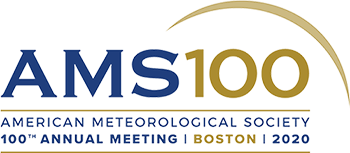A .gov website belongs to an official government organization in the United States.
A lock () or https:// means you've safely connected to the .gov website. Share sensitive information only on official, secure websites.

13 January 2020
Our scientists share their research at this week's American Meteorological Society (AMS) 100th Annual Meeting in Boston, MA (Convention and Exhibition Center). CSD submitted 22 total presentations to the 100th Annual Meeting of the AMS. Ten posters will be presented in addition to the oral presentations and invited talks, all outlined below. Search the AMS 2020 Annual Meeting Online Program for abstracts and session information.
Dan Murphy discusses Contributions by Emissions from Various Regions to the Global Energy Budget at 9:30am, as part of the AMS Session 1 Wisdom of Solomon: History and Successes in Environmental Policy, 205B.
Yelena Pichugina discusses Evaluation of NWP Models Using Scanning Lidar Measurements in Complex Terrain during the WFIP2 Experiment: Lessons Learned at 3:45pm, as part of the AMS Session 4 Wind Forecasting. Part I, 258B.
Karen Rosenlof discusses The Stratospheric Mean Meridional Circulation at 9am, as part of the AMS Session 1 100 Years of Progress in Understanding the Middle Atmosphere. Part I, 255.
Brian McDonald was invited to present Modeling Impacts of Energy and Non-Energy-Related Sources on Urban Air Quality at 9:45am, as part of the AMS Session 4B Air Quality Impacts from Energy Production and Generation. Part I, 207.
Dave Fahey discusses Future Changes to Stratospheric Composition and Their Impacts at 3pm, as part of the AMS Session 4 Future of the Middle Atmosphere: Anticipating Change and Identifying Scientific Needs for Better Understanding, 255.
Karl Froyd discusses Sources of Mineral Dust Aerosol to the Cirrus-Forming Regions of the Upper Troposphere at 11am, as part of the AMS Session 7 Advances in Observational and Modeling Studies of the Role of Mineral Dust in the Earth System. Part II, 208.
Meng Li discusses Evaluating a Bottom-Up Inventory of Oil and Natural Gas Emissions with OMI and TROPOMI Satellite Retrievals at 11am, as part of the AMS Session 10A ACMAP: Atmospheric Chemistry Modeling and Analysis Program. Part V, 206B.
Bob Banta discusses Using Doppler–Lidar Measurements of Recurrent Diurnal Marine Air Intrusion Flows into the Columbia River Basin to Characterize and Quantify HRRR Errors at 8:45am, as part of the AMS Session 11B Numerical Modeling for Recent Field Campaigns and Testbeds, 258B. * Banta is an AMS 2020 recipient of a Bulletin of the American Meteorological Society Editor's Award for thorough, insightful, and impartial reviews of a particularly provocative manuscript.
Audrey Gaudel was invited to present Tropospheric Ozone Is Still Increasing across the Northern Hemisphere at 10:30am, as part of the AMS Session 13B Quantification and Attribution of Trends in Tropospheric Ozone. Part II, 207.
Owen Cooper provides an update on Multidecadal Surface Ozone Trends at Globally Distributed Remote Locations at 11am, as part of the AMS Session 13B Quantification and Attribution of Trends in Tropospheric Ozone. Part II, 207.
Greg Frost discusses Characterization and Application of JPSS (Joint Polar Satellite System) Products in Biomass Burning Studies at 11:45am, as part of the AMS Session 12B Special Session on the JPSS Series Satellite System. Part II, 207.
Steve Brown was invited to present Nitryl Chloride in the Urban Winter: Results from Recent Aircraft Campaigns at 4:45pm, as part of the AMS Session 15B Atmospheric Halogen Chemistry and Its Impacts. Part II, 207.